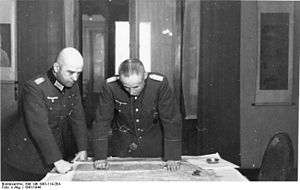Ernst August Köstring
| Ernst-August Köstring | |
|---|---|
|
Ernst-August Köstring (right) along with Hans Krebs (1941) | |
| Born |
20 June 1876 Russian Empire |
| Died |
20 November 1953 (aged 77) Unterwössen, West Germany |
| Allegiance |
|
| Service/branch |
|
| Years of service | 1895–1933; 1935–45 |
| Rank | General der Kavallerie |
| Battles/wars |
World War I World War II |
| Awards | Knight's Cross of the War Merit Cross with Swords |
Ernst-August Köstring (20 June 1876 – 20 November 1953) was a German diplomat, officer and General of Cavalry in World War II.
Career
Born in Imperial Russia in 1876, Ernst August Köstring grew up in St Petersburg and was fluent in Russian. [1] He took part in World War I, serving under Major General Hans von Seeckt in the Austro-Hungarian Seventh Army. After the war he remained in the army commanding the 76th Landwehr Infantry Regiment from November 1918 to 3 March 1919. From 1919 he was back in the Prussian War Ministry and then detached to the Ministry of the Reichswehr in 1919 when that ministry was established. He spent the rest of the decade alternating between spells in regiments, riding schools and positions at the Ministry finally ending up in Moscow as secret special military attaché. He retired from the army on 31 March 1933.
On 1 August 1935 he was returned to active service as a military attaché to Russia and Lithuania and sent back to Moscow. On 8 August 1940 Köstring was warned by General Franz Halder that "he would have to answer a lot of questions soon",[1] making him one of a few people who knew what would happen with Russia despite the non-aggression pact. With the planned Operation Barbarossa his position in Moscow was untenable; he was repatriated under diplomatic immunity and assigned to the Führerreserve. He visited, together with Friedrich Werner von Schulenburg, prisoner of war camps selecting Russian volunteers for the army.
On 1 September 1942 when he was ordered to be the "General Officer attached to Army Group A for Caucasian Questions" (allegedly assigned due to the influence of his friend Claus von Stauffenberg) under General Eduard Wagner. In this role he worked on creating national legions among the indigenous people of the Caucasus, among them the Muslim Karachai. Trying to get them autonomy however, could be in direct confrontation with the policy of the Office of the Four Year Plan. He arranged for Armenian, Georgians and other Caucasian populations to fight at the front after training in Poland. Most of the Armenians deserted.
The Karachai had formed an anti-Bolshevik committee under Kaki Baieramukov before the Germans arrived. Köstring invited them to a Bairam feast on 11 October. He was so well received he was carried shoulder high in celebration as was the custom. Unfortunately, members of a Four Year Plan mission were also at the feast and a speech was made informing them that although they had been liberated they now served the Fuhrer. An eyewitness states that the speech was not translated this way but was explained that they would be left in peace.
In the spring of 1943 Köstring put into the Führer reserve. In mid-June 1943, he was appointed Inspector of the German commanded Turkic associations, on 1 January 1944 appointed the General of the "volunteer" organizations in the Army High Command. Throughout this period he spent most of his time helping with the creation of Vlasov's army. He surrendered on 4 May 1945 to the U.S. Army; he was released in 1947. He co-authored the book The Peoples of the Soviet Union for the U.S. Army in 1948.
References
Sources
- Mitcham, Samuel W. (2009) Men of Barbarossa: Commanders of the German Invasion of Russia 1941. Casemate.
